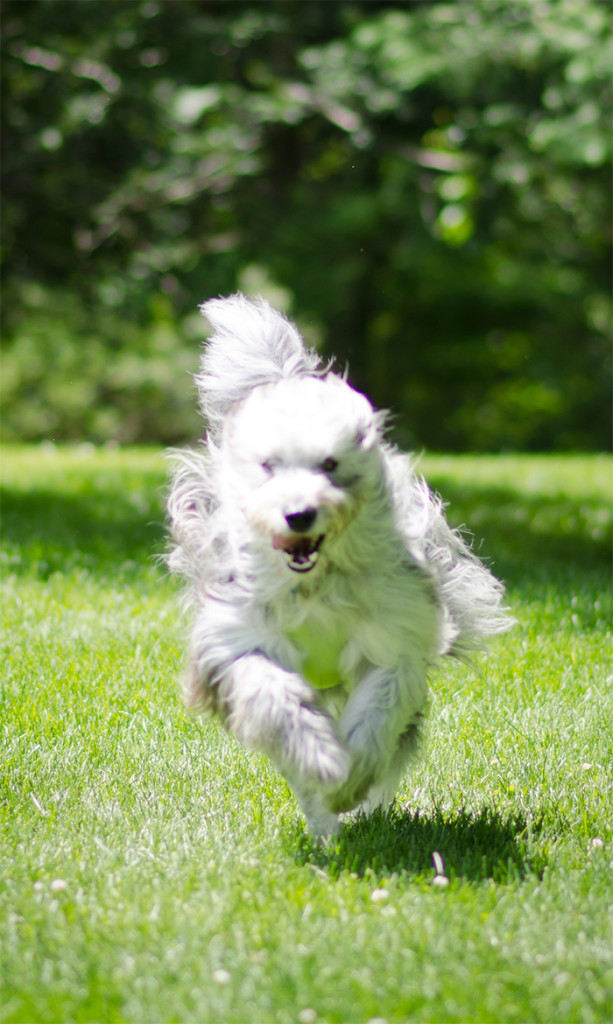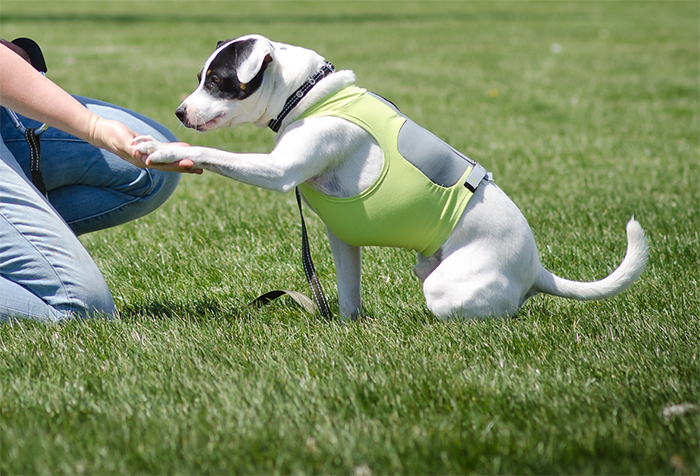
Download Badge and add to your site or post it! #NCFM
This month is National Canine Fitness Month! Exercise is so important for your canine for so many reasons and behavior is one of those reasons!
Have you ever had that moment when you questioned taking your dog for a walk because it barks at everything that moves? Or have you ever felt your heart just break when your fearful canine companion becomes overcome with anxiety due to a fear or phobia? These are just a few of the behavior problems facing many families today. Unfortunately, many dogs are relinquished every year as a result of these problems.(4)
So, what options do owners have when it comes to dealing with these issues? Change begins with a solid multifaceted behavior intervention plan including your veterinarian and qualified professionals. It is imperative that this plan takes into account all aspects of the owner’s lifestyle and resources in order to keep dogs out of shelters and in their family homes. Exercise can be a key component in a behavior modification plan and can aid in solidifying the learning of more appropriate behaviors.
 What examples come to mind when I say the word exercise: a walk in the neighborhood, a trip to the dog park, or maybe a hike on a trail? Exercise can mean many things to many people, but no matter what we choose as a means to stay fit the benefits are clear including such positive health effects as increased longevity, lower weight, fewer health problems, and more energy. Recently, the New York Times has touted exercise as, “The closest thing to a wonder drug.”(2)
What examples come to mind when I say the word exercise: a walk in the neighborhood, a trip to the dog park, or maybe a hike on a trail? Exercise can mean many things to many people, but no matter what we choose as a means to stay fit the benefits are clear including such positive health effects as increased longevity, lower weight, fewer health problems, and more energy. Recently, the New York Times has touted exercise as, “The closest thing to a wonder drug.”(2)
But how do we use exercise in a meaningful way with our pets to reap these benefits while also helping them deal with a behavior problem? It starts with an understanding of the effects of exercise and how that translates into everyday life.
There’s a long history of recommending exercise for common behavior problems in dogs. You have probably heard the saying, “A tired dog is a good dog.” While there is merit to this suggestion, a lack of understanding of what aspects of exercise are affecting behavior causes owners to think exercise is all their canine family member needs.
Many of the problems owners are dealing with involve anxiety, phobias, reactivity, and aggression. No single approach will fix these problems, but when you attack these issues from multiple directions we can see significant results.
When we exercise our dogs, there is much more at work than just tiring them out. Inside that passed out pooch is a network of activity thriving off of the effects of exercise. When dogs (and humans) exercise there’s a spike in certain chemicals in the brain. These chemicals are like Miracle Grow for all the neurons in the brain that carry information from one place to another. Research shows that consistent exercise helps build and strengthen these neurons like the branches and roots of a tree, solidifying the information we take in from our environment.(5)
Additionally, a good physical workout isn’t the only way to exercise our dogs; mental exercise is just as important. Both kinds of exertion stimulate a dog’s brain and when we stimulate the brain physically and mentally at the same time dogs (and other animals, including humans) have an easier time remembering and picking up a new task.(1,6)
Take, for example, your reactive canine and those dreaded walks. What once seemed like an impossible endeavor can now be a positive experience with the integration of some exercise and mental games. If we can keep the reactive dog engaged in an activity, for example balancing on a K9FITbone, while another dog walks by at a safe distance we can begin to change the way they react. Eventually, the equipment can be faded out and the dog will be on a path to making better choices.
Think of this type of training as laying down new paths in the brain where the old path leads to anxiety and the new path leads to a sense of calm that is being enhanced through training and exercise.
Not only does using exercise serve as a means to maintain focus and offer mental stimulation, exercise has direct effects on the anxiety itself.
Animals and humans who exercise often experience a decrease in symptoms of anxiety and depression. Exercise can also reverse and protect people and animals from the detrimental effects of large amounts of stress.(3)
The anxiety and stress of a dog with fear and anxiety, which is at the root of many of the more serious behavior problems, is not something to be taken lightly. Exercise may help to relieve this anxiety, and consequently put the dog in a better position to absorb training.
As we can see, living with a dog that has a behavior problem can be worrisome for a family. Not only do families feel helpless at times and saddened by what their dogs are experiencing, they can also feel the social strain that comes from caring for a dog with a more serious issue. While exercise is not a cure all for many of the problems families are facing, it can be an integral part of an all-inclusive plan that stacks the odds in our favor.
 About the Author: Genevieve Cahill, founder of Modern Animal Behavior has been a Certified Veterinary Technician for 15 years. All throughout her life she has been very passionate about two subjects, fitness and behavior. She completed her two undergraduate degrees in Psychology and Communication and is now pursuing her Masters Degree in Companion Animal Behavior Counseling. Recently, Genevieve found a way to merge her two passions via the FitPAWS Master Trainer/ University of Tennessee Canine Fitness Trainer program and her masters thesis work researching how exercise enhances learning/behavior in shelter dogs. Genevieve believes that behavior and exercise can be completely intertwined and is passionate about bringing that message to pets and their owners. Genevieve’s background as a Certified Personal Trainer through the National Academy of Sports Medicine (NASM) and her many years as a Veterinary Technician have prepared her to jump right into this up and coming world of canine fitness.
About the Author: Genevieve Cahill, founder of Modern Animal Behavior has been a Certified Veterinary Technician for 15 years. All throughout her life she has been very passionate about two subjects, fitness and behavior. She completed her two undergraduate degrees in Psychology and Communication and is now pursuing her Masters Degree in Companion Animal Behavior Counseling. Recently, Genevieve found a way to merge her two passions via the FitPAWS Master Trainer/ University of Tennessee Canine Fitness Trainer program and her masters thesis work researching how exercise enhances learning/behavior in shelter dogs. Genevieve believes that behavior and exercise can be completely intertwined and is passionate about bringing that message to pets and their owners. Genevieve’s background as a Certified Personal Trainer through the National Academy of Sports Medicine (NASM) and her many years as a Veterinary Technician have prepared her to jump right into this up and coming world of canine fitness.
(1)Berchhold, N.C., Castello, N., & Cotman, C.W. (2010). Exercise and time-dependent benefits to learning and memory. Neuroscience, 167(3), 588–597. doi:10.1016/j.neuroscience.2010.02.050.
(2)Carroll, A.E. (2016, July 16). Closest thing to a wonder drug? Try exercise. The New York Times. Retrieved from https://web.archive.org/web/20210501000317/https://www.nytimes.com/2016/06/21/upshot/why-you-should-exercise-no-not-to-lose-weight.html?_r=0
(3)Greenwood, B.N., Strong, P.V., Dorey, A.A., & Fleshner, M. (2007). Therapeutic effects of exercise: Wheel running reverses stress-induced interference with shuttle box escape. Behavioral Neuroscience, 121(5), 992-1000. doi:10.1037/0735-7044.121.5.992
(4)Overall, K. (2013). Manual of Clinical Behavioral Medicine for Dogs and Cats. St Louis, MO: Elsevier.
(5)Ratey, J. (2008). Spark: The Revolutionary New Science of Exercise and the Brain. 237 Park Avenue New York, New York: Hachette Book Group USA.

